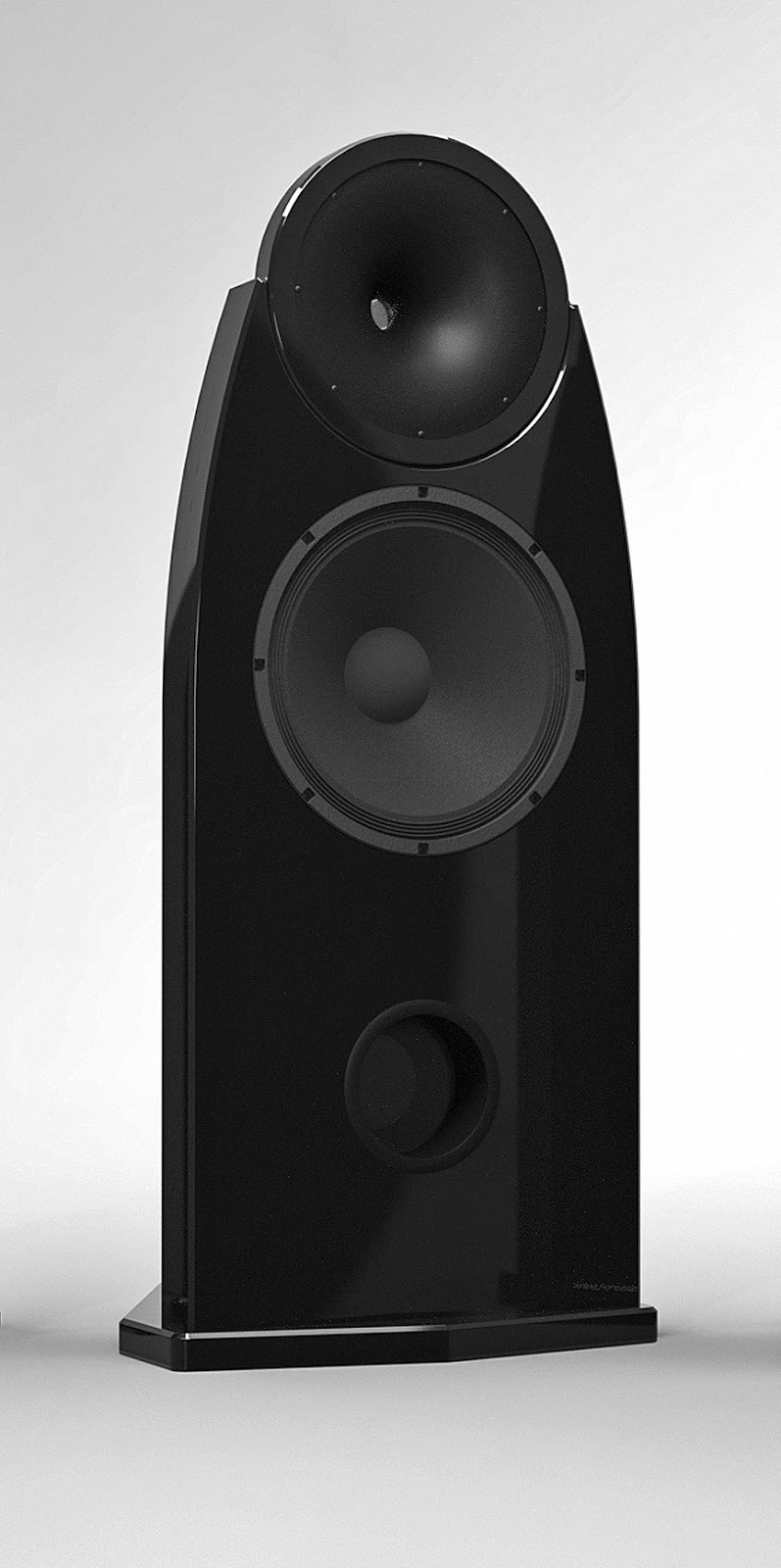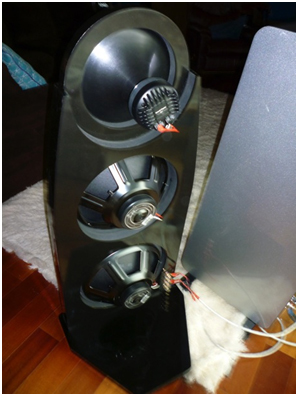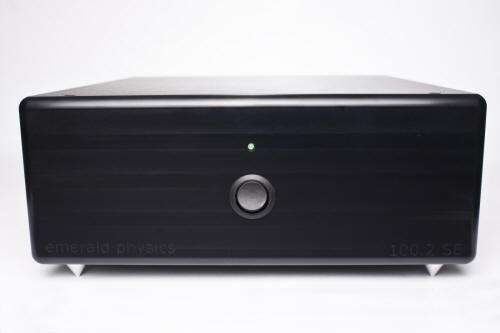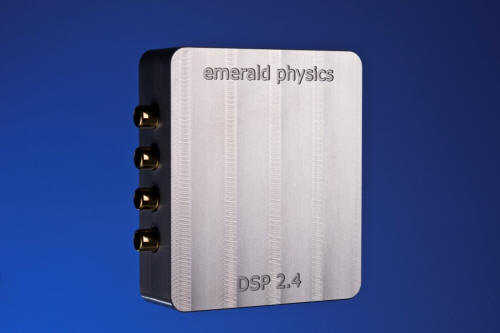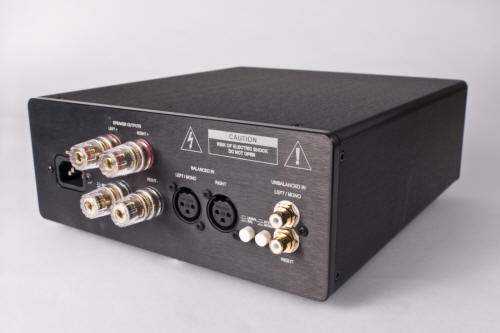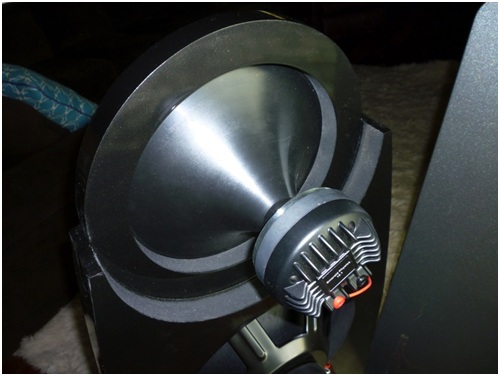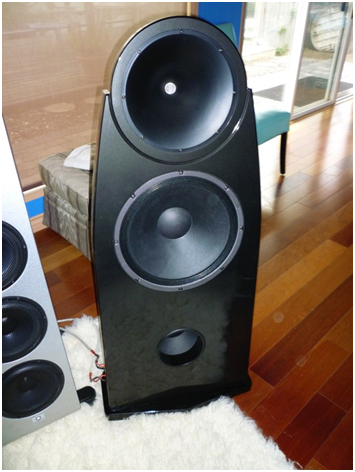|
|
You are reading the older HTML site
Positive Feedback ISSUE 70
emerald physics CS2P Loudspeaker System as reviewed by Michael Wechsberg
The high cost of so many of the best sounding speakers really bothers me. These days it seems like the sky's the limit on top-end speakers, and I guess the small percentage of audiophiles out there who can afford these behemoths are enough to keep quite a few companies going. Even a value brand like Vandersteen now has a $50,000 speaker in their line. Therefore, it is very refreshing and exciting to have the chance to listen to the Emerald Physics CS2P speakers that go completely in the other direction price-wise, but compete sonically with some of the best speakers I have heard. Praise should also go to audiophile and businessman Walter Liederman who sells these "Made in USA" speakers direct to the consumer from his headquarters in Lahaina, Hawaii (Walter is obviously no dummy; he's also one of the nicest gentlemen in the business). I have heard the CS2Ps, and other Emerald Physics speakers at several recent audio shows, and have always been impressed, if not a bit skeptical. After all, these things only cost around $3000, and moreover, they use digital signal processing so they can't possibly be in the same class as some of those other sonic blockbusters with a 5-figure price tag, can they? One of the reasons some speakers have become so expensive is the money lavished on elaborate speaker cabinet designs. Think of Magico, Rockport, Wilson, YG Acoustics, and many others. It is not a secret that speaker cabinets contribute significantly to the sound of a speaker, so designers have worked hard to reduce, eliminate, or control cabinet sound effects. Often in the top-end designs the solution is a cabinet that is very heavy, is made from exotic materials, or requires elaborate machinery or significant labor to shape or put together. Some speaker manufacturers have had to invest millions of dollars in computer-aided machinery to make their cabinets and other speaker components. When the manufacturer sets his price to cover the cost of the cabinet materials and labor, plus the overhead that pays for the machinery, and the distributor and dealer add their markups as a percentage on top of the manufacturers cost, the result is often in the five or six figures. Emerald Physics has gone in the completely opposite direction. Instead of lavishing endless hours designing a cabinet, they have focused on making a worthwhile design with basically no cabinet at all. And, they sell direct to the consumer over the Internet, eliminating the middleman's markup and quite a bit of overhead. The result is the elimination of major cost elements without having to go to China for lower labor cost. (EP assembles the speakers in Colorado, and ships from their warehouse in Georgia). I have nothing but admiration for this approach, and I encourage other audio designers to think "outside the box" like this for their designs. Of course this would all be fruitless if the sonic results weren't there. Fortunately, EP has come through. After THE Show Newport this year, I asked Walter about reviewing one of his speaker sets. In addition to speakers, Emerald Physics makes their own amplifiers and digital processing hardware and software, and this is the way they are usually demonstrated at shows. On the EP web site the company offers each of their speakers together with alternative preamps and amps at a generous system-level discount. I, therefore, asked Walter about reviewing a complete EP system, including amplification, processing, cables, the whole nine yards except for the front end. So, a few weeks later, EP sent me a pair of the CS2P speakers with passive crossovers, a Peachtree Nova1tube hybrid preamp/DAC, two EP 100.2 amplifiers, one EP 60.2 amplifier, two of their DSP 2.4 boxes (one with a software load suitable for single amp operation, and a second with a software load suitable for biamplification), and a complete set of RCA interconnects, speaker cables, and power cords from Wireworld. The list price of all this is $10,200, but EP will sell it to you direct for only $5999 ($4999 without the cables). The speakers by themselves are $2990 in the standard black finish. That is a tremendous bargain considering the quality of sound produced by this system as you will read below.
Description EP describes the CS2P as a 2.5 way passive, open-baffle, dynamic loudspeaker with optional biamplification. A custom-designed 1-inch compression driver mounted at the apex of a circular waveguide, with a 12-inch outside diameter, handles the midrange and treble above 1kHz. Two 15-inch fiber pulp cones, mounted one above the other, handle everything below 1kHz. All three drivers are installed in a 3-inch thick baffle made of MDF. The baffle is supported by a sturdy wood bass that tilts the drivers back slightly and extends about 16-inches behind the front baffle. The upper bass driver is completely open for all to see, but the lower driver is partially covered by the baffle with only the center 6-inches open. It almost looks like a port, but there is a full 15-inch driver behind it. The skill in designing an open baffle speaker is dealing with the rearward firing sound interfering with, and partially cancelling the sound coming out the front. By covering the bottom woofer it alters the signal path, and the way cancellation occurs between the two woofers thereby extends the low-frequency response. This accounts for EP calling it a 2.5-way system instead of just a 2-way. EP specifies an impedance of 4-ohms and 93 dB efficiency. Frequency response of the raw speaker is given as 40Hz to 20kHz +/- 3dB. The speakers stand 50.5 inches high and 22 inches wide, and weigh 80 pounds each. The standard finish is matte black, but several optional finishes are available at extra cost. My pair had a gloss black automotive Tri-coat finish, adding $1000 a pair to the price. In my opinion this extra cost is worth it.
EP has configured the CS2P for staged improvements as your budget allows. You can buy the speakers alone with passive crossovers and use your own amplifiers. The next addition would be a DSP2.4 digital processor that provides some equalization, bass extension, and compensation for near-wall reflections. You can next add an EP amplifier. The 60W/channel 60.2 amp is a bit underpowered to drive the speakers to loud levels (especially in the bass) in a moderate to large room, but if you are not a loudness freak it should be adequate. The 100W/channel 100.2 is a better choice overall. The next step is to go to biamplification. This requires removing the passive crossover boxes, changing the software load in the DSP2.4, and adding a second amplifier. Or, you can adopt the configuration I was supplied with, three amplifiers wherein the two EP 100.2 amps are each operated in bridged mode (yielding 200W/channel into 4 ohms) with a single 60.2 in stereo to drive the high end. The Emerald Physics 100.2 and 60.2 amplifiers are both stereo class D designs with analog power supplies all manufactured in the US. The 100.2 is rated at 100W per channel, and can drive down to a 3-ohm load. This amplifier is bridgeable and in that mode can produce 250W. It has both RCA and XLR inputs on the back with good quality speaker binding posts. A power switch and light are on the front panel. The chassis is a very plain black (a silver version is also available), but gets the job done. The relatively compact dimensions are 9" W x 10" D x 3.5" H and the amplifier weighs 11.5 pounds. EP claims this amplifier is 93% efficient, and I can confirm the chassis barely got warm even when playing music for hours at moderate to high levels. The slightly smaller 60.2 amplifier is rated at 60W per channel, but can be bridged to produce 150W mono. It is the same width and depth as the 100.2 but stands only 2.5 inches high and weighs about 10 pounds. It also comes in silver and black. I had some problems setting up the amplifiers for biwire operation due to some errors in the supplied manuals. EP tells me the manuals are being re-written, and should be in much better shape by the time you read this.
The DSP2.4 digital processor comes standard with most of the EP speakers, but is an $850 option on the CS2P. It packs quite a bit of processing power in a small package as it contains an ADC, a DAC, and a digital processing chip that performs multiple programmable functions. If you purchase the DSP2.4 it is inserted between the preamp and amplifier where it digitizes all analog signals going into it via 2 RCA jacks. It also has 4 output RCA jacks. If you are using just a single amplifier the DSP2.4 is programmed to perform equalization to flatten out the frequency response of the CS2P, including extension of the bass response down to 24 Hz. It also compensates for side wall and front wall reflections to sharpen up images (this processing is mostly additional equalization, but may include some manipulation of the signal phase as well). If you choose to biamplify, then the DSP2.4 software load is modified to include the crossover function and a different set of equalization weights. EP provides a number of different software loads on their web site, and they provide instructions to download the necessary version and install it in your unit. The DSP2.4 uses 24-bit ADCs and DACs with a sampling frequency of 48kHz. You may know that today much higher sampling frequencies are possible, but I was told EP chose 48kHz to keep the cost down. A higher sampling rate processor may come out in the near future. It seems a pity to digitize everything at such a low sample rate. Say you have a DAC that upsamples everything to 192kHz like I do. The DAC converts this to an analog signal only to be digitized again in the DSP2.4 at a 48kHz rate (after passing through yet another set of interconnects) and then going through a second DAC. Serious audiophiles will be profoundly disturbed by this concept, and this alone might deter them from considering the CS2P speakers (and others in the Emerald Physics line). On the other hand, the CS2P manages to be a highly musical transducer despite the use of all this digital processing, in fact the DSP2.4 contributes significantly to the quality of the sound. I had some ergonomic problems with this little DSP gadget. Power for the digital processor comes in via a mini-USB connector that plugs into the wall via an adapter similar to the one supplied with my iPhone. There is no power switch, so the processor stays on all the time (probably a good idea so everything remains at thermal equilibrium). On several occasions I turned on the system only to be greeted with no sound. Most often the problem was the mini-USB connector working its way loose. Since the DSP2.4 box is so small and light it moves around with the 6 cables attached to it making it easy for the power connector to get loose. EP tells me that in future production they will add a light to the box so the user can tell whether or not it is turned on. I also found that the RCA connectors were quite close together. Although this was okay with the supplied Wireworld cables, there may be a fit problem with some other RCAs. As mentioned, EP sent me a complete set of Wireworld cables to use for the review. RCA interconnects were the Oasis 7, which are in about the middle of the range of Wireworld products. I also got the Solstice 7 Speaker Cables that use 13-gauge conductors, and a complete set of Stratus 7 power cords. The latter are Wireworld's entry-level power cord, but follow the same construction techniques as their higher level products, but with more cost effective materials. During my review I did not attempt to separate out the sound of the cables from the rest of the equipment. However, during break-in I did try the interconnects and a couple of power cords in my reference system. I found these cables to have a relatively neutral sonic signature with good performance at the frequency extremes. I came away with the feeling that EP's choice of cables was quite suitable to allow the inherent sound of the amps and speakers to come through. Set-up My original intention was to review the CS2P system in its "ultimate" configuration with biamplification, but Emerald Physics sent me the passive crossovers, and a second DSP box so I could listen first with just a single amplifier and build up to biamplification. I decided to do just that. I set up the speakers in my listening room along the long dimension of the room so they would be well away from side walls. I also set them about 5-feet out from the front wall. Since these speakers act like dipole radiators below 1 kHz they are somewhat sensitive to what is behind them (but less so than some other dipole designs that radiate out the back over a wider frequency range). What I have behind the speakers (unfortunately) is a pair of large picture windows covered with sun shades. In between is a stone fireplace. Because of the position of my equipment and other speakers, I had limited capability to vary the speaker to front wall distance (only made sense to move them +/- 6 inches). I could vary the spacing between the speakers and the toe-in. I ended up with the speakers about 9 feet apart and 9 feet from my listening position resulting in an equilateral triangle geometry. This gave me some very good imaging and a wide soundstage. Initially I pointed the speakers straight ahead, but this would change as time went on.
I decided not to use the Peachtree preamp/DAC that EP sent me (I plan to check this unit out separately and, if warranted, write a separate review). I felt using it would result in too many changes to my reference, and make it too difficult to get a handle on the sound of the speakers. In addition, the Peachtree does not have a phono input and I did want to use some LPs in evaluating the system. Instead I stuck with my reference front end components consisting of the E.A.R. 868 preamp and E.A.R. Acute 3 CD/DAC. I also used my Townshend Rock 7 turntable. The speakers come with a pair of black boxes containing the crossover components. These have about 9 inches of wire to make the connections to the two pairs of speaker terminals on each speaker. I just set these crossover boxes on the bases of the speakers with some foam padding underneath to cut down on any vibrations affecting the crossover electronics. I was told the speakers need 50+ hours to break in. The initial pair of 100.2 amplifiers I received had a problem and I returned them to EP for repair. I used the 60W EP amplifier for break in, and later substituted a pair of Nuforce monoblocks loaned to me by a friend. Initially, the speakers sounded quite bright and the bass went deep, but seemed a bit flabby. Both these effects disappeared after a few hours of use. After breaking in the speakers, and upon return of the 100.2 amplifiers, I listened to the system for a few days with the passive crossovers alone. Then I added the DSP2.4 containing the software load for a single amplifier. The DSP had a significant impact on the sound described in the next section. After a few more days I removed the passive crossovers and first DSP, and inserted the second DSP2.4 with the software load for biamplification. This DSP implements an active crossover as well as a different equalization curve. I also configured the two 100.2 amps for bridging and used them to drive the low end of the two speakers. I used the single 60.2 amplifier in stereo to drive the high end. This is the "ultimate" configuration for best sound according to EP.
Listening Listening to the speakers with a single 100.2 amplifier and the passive crossovers without the DSP impressed me with its full range response and a broad and deep soundstage. The speakers themselves seemed to disappear with no distracting resonances or boxy sounds. The lows extended below 40Hz in my room with very good transient snap and detail. This was more than adequate for most music. The sound was a shade thin through the midbass (something that could be due to room) but was firm and sure throughout the midrange. The high end had a lot or sparkle and air, and was especially transparent and detailed on LPs. Increasing the toe-in resulted in a too-bright sound, but between 5 and 10 degrees toe-in produced the best compromise. The overall spectral balance was still tilted slightly towards the high end, that is, there seemed to be more high-end energy than low-end energy, but I would not say the sound was overly bright. It had a good deal of harmonic detail that imparted an impressive realism to the overall sound picture. The midrange was wonderful, particularly on voices, but also on orchestral music where strings, piano, and woodwinds were portrayed especially well. Most importantly music of all types had rhythm, pace, and a coherency that was truly impressive in a speaker of this price range. I want to point out this performance was with the EP 100.2 amplifier, which I found to be very transparent and capable when used with these speakers. The other set of solid-state amplifiers I used with the CS2P did not provide as airy a high-end response, nor equally well-defined bass. On the other hand, it was obvious that the frequency response of the system was not flat, especially in the high end that had some peakiness. The lows were a bit lumpy as well (of course this is highly room dependent), but the overall impression was a positive one. It should also be noted that these speakers can play loud with excellent transient behavior to be expected with such an efficient design. Thus, listening to the CS2P system as a straight up 2.5-way speaker is a rewarding experience, fully consonant with its price. For the next round of listening tests I played the same CDs and LPs as the first round, but this time I inserted the DSP2.4. This changed things quite a bit.The DSP digitizes everything going into it at 24-bits and 48kHz sample rate, does some digital equalization and phase correction, and then converts the music back to analog. Subjectively I found the DSP significantly boosts and extends the low end, while smoothing out and rolling off the high end. While I can't confirm the lows extend down to 24Hz, I can say the bass tightened up considerably. The lows were already pretty much full range without the DSP, but with it the bass was even more impressive. The DSP also fills in the upper bass and lower midrange making the overall sound quite a bit more solid and better defined. In the upper frequency range the equalization flattened out the response that should make the sound closer to reality, but subjectively I found the sound a bit dull. More importantly I sensed a loss of air and detail. For example, one of the LPs I played was a recording of Stravinsky's Song of the Nightingale prominently featuring the sound of a triangle. Without the DSP it was possible to hear individual tones struck on the instrument, but with the DSP inserted the sound seemed more like one continuous long note. One positive thing about the use of DSP was it sharpened up images within the soundspace. As noted the imaging, even without DSP, was wide and deep and the speakers completely disappeared. Use of DSP solidified and sharpened the images within the soundspace. Voices and instruments could be located with greater precision, and they stayed in the same place even as the instruments played up and down their musical scales. I would say the image plane on most of recordings was set back a bit compared to what I heard without DSP, and there was a tad more depth. This improvement is likely due to the signal processing to compensate for the presence of the front and side walls. I expect this would be even more evident in a smaller room where boundaries are closer to the speaker than they are in mine.
On the negative side, the DSP'd speakers lost some of their coherency and rhythmic drive compared to the no-DSP case. I may feel this way just because of the spectral shift imposed by the DSP that favors the low end instead of the high end. More likely it is due to limitations of the digital processing. Here is a place where some higher speed digital devices might do better. So, adding digital processing to the CS2Ps with a single amplifier has some plusses and minuses. The digital processing improves the bass, solidifies images, and gives the speaker a more neutral tonal palette. On the other hand, it robs the basic system of some of its coherency and vividness. I next hooked up the system in biamp mode with the 100.2 amps set up for bridged operation, and the 60.2 amp used for the high end. The passive crossover boxes were removed and I swapped in the second DSP2.4, pre-loaded with parameters reflecting the way I had the speakers set up in the room for biampliciation. The first thing I noticed, after making this change, was noticeably tighter and better-defined bass. In fact, the improved solidity and definition extended up into the lower midrange. Measurements made with my old Radio Shack sound level meter, after most of my listening tests were done, revealed that low bass (below 80Hz) was boosted by an extra dB relative to the amount of boost applied with single amplification. In talking with EP they confirmed the extra bass boost. EP feels that with the additional dynamic range possible with the bridged amplifiers, they could push the bass a bit more than they could when only a single amplifier is used. In any event the bass response I heard with the equalized CS2Ps was lively, deep, and very articulate. The best bass I have ever heard in my room. I can't vouch for the calibration of my sound level meter, but the readings indicated the bass was flat down to the mid-30Hz range and still audible at 25Hz. The only complaint I have is that the speakers really excited the 50Hz room mode that I suffer from, resulting in too much bass on a few recordings. Otherwise I can guarantee you will like the low frequency performance of the speaker set up for biamplification. I also heard the pinpoint imaging that was evident when DSP was added to the single-amplifier system. I became even more aware of the sound of the room in classical recordings, and the soundstage was even wider than before. I believe this was enabled by the elimination of the crossover components. On the other hand, the tonal palette still seemed a little dark to me, as was the case with a single amplifier and DSP. I ended up increasing the toe-in to about 20 degrees so the high-frequency driver was pointing more directly at the seating position. This improved detail, transparency, and resolution to near reference levels. The speaker may not be quite as flat this way compared to lesser toe-in, but tonally it sounded better to me. The only weakness remaining was in the treble where this speaker is only good, and not great. This could be a limitation of the digital processing or it might be that different cables or amplifiers could make things better. Summary The Emerald Physics CS2P and their amplifiers provide almost everything most music lovers want. A beautiful open sound, spectacular dynamics, thundering bass, and pinpoint imaging combine to allow the listener to appreciate the heart and soul of the music. That this is all possible for around $5000 is amazing. The most negative thing I have to say about this system is that the speakers are large, and may be difficult to integrate and accept in some rooms. The size is unavoidable, given the open baffle design approach. However, the engineering design of the CS2Ps, combined with the judicious use of digital signal processing, is brilliant. It is possible to get better sound than this, but one has to spend thousands more to do so. I would say that the weakest part of the performance of the system is in high frequency detail and transparency. These are good, but perhaps not as good as some other aspects of the system. Emerald Physics can probably upgrade performance further by improving the digital processing. This speaker may not be for the most die-hard of audiophiles – it's lacking some of the liveness, coherency, and rhythmic drive of the best systems – but it gets you very close to that ideal for a relatively small amount of money. I also want to single out the Emerald Physics amplifiers, especially the 100W amps. I'm not sure how they would do in a system with radically different speakers, but I found few shortcomings when used with the CS2Ps. They look pretty modest but they pack a wallop! The Emerald Physics speakers are only available for purchase over the Internet. It is hard to audition them, except at regional audio shows or in the home of someone who has purchased them. I strongly encourage you to take advantage of any such opportunity, or, give Walter Liederman a call at Underwood HiFi on Maui. You won't regret it. Michael Wechsberg
Emerald Physics CS2P Speakers in Matte Black
With Emerald Physics DSP2.4 Digital Processor, (2) Emerald Physics 100.2
Amps for the bass, an Emerald Physics 60.2 Amp for the Treble, Peachtree
Nova Preamp/DAC, and Wireworld Oasis RCA Interconnects and Wireworld
Solstice Speaker Cables
Underwood Hifi Inc. |









